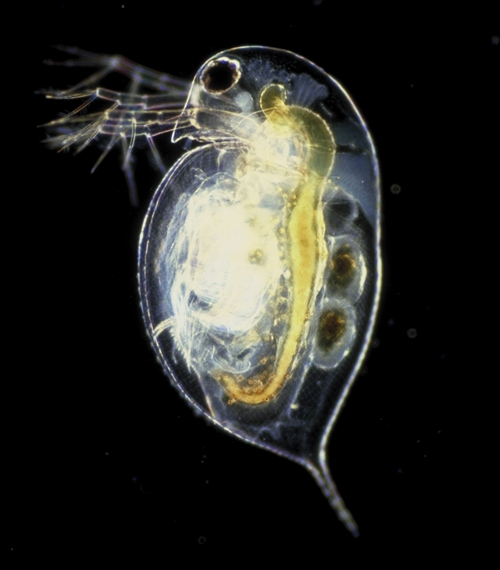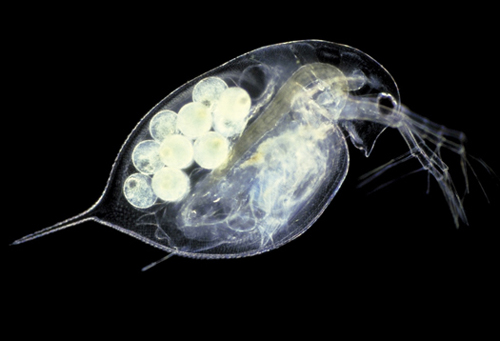
The tiny creature has been used to test toxicity of chemicals in water for decades. Now a team of scientists ─ including a Guelph biologist ─ who have sequenced Daphnia’s genome expect that the “water flea” will become even more important for monitoring pollution, biodiversity and aquatic food webs, and for learning about the often bizarre tricks used by creatures to adapt to environmental change.
Prof. Teresa Crease, Integrative Biology, is part of an international team that has sequenced the entire genome of Daphnia pulex, whose roughly 31,000 genes are the most of any organism yet sequenced. Ten years after publication of the human genome with its 23,000 genes, this is the first crustacean whose genetic code has been sequenced.
Published last week in Science, the paper attracted headlines around the world, from major scientific journals to the Toronto Star and CBC News.
The authors are part of a 450-member international group called the Daphnia Genomics Consortium, based at Indiana University. Crease has belonged to the group’s steering committee since it was formed in 2002. Other researchers conducted hands-on sequencing of that gene-packed genome ─ a mystery in itself, she says. Referring to the water fleas, she adds, “We don’t understand why they need so many genes.”
Daphnia live mostly in freshwater, although some species can live in brackish or highly saline environments. They eat algae and are an important food source for other aquatic creatures.
Crease studied population genetics of D. pulex for her master’s degree completed in 1981 with Prof. Paul Hebert, now director of U of G’s Biodiversity Institute of Ontario.
Quoted on CBC News, Hebert said the newly sequenced genome might help improve environmental monitoring that uses Daphnia as a so-called “sentinel” species for pollutants or toxins. Low oxygen in water caused by farm runoff, for instance, might trigger its genes to make more hemoglobin, thus alerting scientists to changes in water quality, he said.
Environmental changes can cause Daphnia to do even more bizarre things, says Crease. Chemical or hormonal changes in water can signal the creature about stresses such as overcrowding, pollution or a predator threat. In response, the organisms can produce young with special body features such as helmets, long tails or neck-teeth.
Those changes are under genetic control, says Crease, as is another kind of response to environmental stress. Sensing that its pond home might soon dry up, for instance, Daphnia can switch from normal cloning to sexual reproduction.

Alternating between the two forms of reproduction is called cyclical parthenogenesis. It’s common in single-celled creatures like yeast, which normally just divide into new cells but can produce spores to populate new areas. Only a few larger, multicellular organisms use cyclical parthenogenesis, including Daphnia, aphids and rotifers, another form of plankton.
“That’s what is unique,” says Crease. Female Daphnia ─ and all of those clones are, of course, females ─ produce eggs sexually that are stored store in a resting egg case until the time is ripe for their release. “It’s a rare system.”
Scientists don’t know why organisms like Daphnia are able to do this. Crease says another mystery is why the creature’s genome contains so many genes, although its unusual life cycle might call for a more complicated genetic toolkit.
Compare Daphnia’s 31,000 genes with our 23,000, she says: “A lot of things that people consider less complicated have more genes. In our life cycle, it’s pretty simple. Egg, sperm, zygote ─ you’re done.”
The Guelph molecular biologist has worked with Daphnia in the field and in the lab for decades. Although she receives lab specimens from across North America, she says finding them is as easy as scooping a net into a pond in the U of G Arboretum.
She has published more than 50 papers on Daphnia genetics. “I want to understand how families of genes evolve.